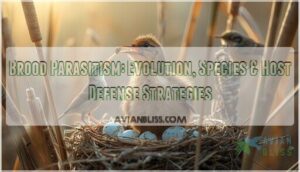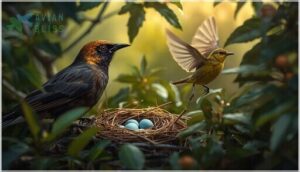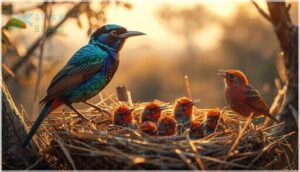This site is supported by our readers. We may earn a commission, at no cost to you, if you purchase through links.
When a reed warbler carefully feeds a chick nearly twice its size—a chick that has already murdered its own offspring—you’re witnessing one of nature’s most ruthless evolutionary gambits. Brood parasitism turns the caregiving instincts of unsuspecting host species into a weapon, allowing parasitic birds to abandon all parental duties while their young hijack another bird’s nest.
This isn’t occasional opportunism; obligate parasites like cuckoos have entirely relinquished the capacity to raise their own young, their entire reproductive strategy hinging on deception and exploitation.
The evolutionary arms race between parasites and hosts has produced some of the most intricate adaptations in the avian world—from egg mimicry so precise it fools even expert eyes to chicks that instinctively evict rival eggs within hours of hatching. Understanding these dynamics reveals how coevolution shapes behavior, physiology, and ultimately the delicate balance of entire ecosystems.
Table Of Contents
- Key Takeaways
- What is Brood Parasitism?
- Evolution and Adaptations of Brood Parasites
- Notable Brood Parasitic Species
- Host-Parasite Interactions and Defenses
- Ecological and Conservation Impacts
- Frequently Asked Questions (FAQs)
- How did brood parasitism come to be?
- What are the chances of dying from a parasite?
- What is a brood parasite?
- Why is brood parasitism important?
- What is a brood parasitism?
- Why is brood parasitism bad?
- Why are cuckoo birds called brood parasites?
- Which of the following are examples of brood parasitism?
- How do brood parasites locate suitable host nests?
- Can brood parasitism occur between different bird families?
- Conclusion
Key Takeaways
- Brood parasitism represents an evolutionary strategy where species like cuckoos and cowbirds have entirely abandoned parental care, instead laying eggs in host nests and forcing other birds to raise their offspring—a behavior that has evolved independently at least 59 times across various taxa.
- The evolutionary arms race between parasites and hosts has produced sophisticated adaptations including precise egg mimicry that can fool expert observers, rapid chick development that gives parasites a 30-hour hatching advantage, and host defenses like egg rejection that can reach 87.5% success rates against poorly matched parasite eggs.
- Brood parasitism creates severe ecological consequences, reducing host reproductive success by up to 68% in parasitized nests and driving population declines in vulnerable species, while climate change now threatens to disrupt the critical timing synchronization between parasites and their hosts.
- This host-parasite relationship functions as a continuous coevolutionary process where neither side dominates permanently—hosts evolve better recognition and rejection abilities while parasites refine their mimicry and deceptive tactics, creating an ongoing cycle of adaptation and counter-adaptation.
What is Brood Parasitism?
Brood parasitism represents one of nature’s most cunning reproductive strategies, where certain species offload the entire burden of raising their young onto unwitting hosts. This behavior challenges our assumptions about parental care—some birds never build nests, never incubate eggs, and never feed their own offspring.
Brood parasitism is nature’s ultimate con: some birds never raise their own young, exploiting unwitting hosts to do all the work
To understand how this strategy works and persists, you need to grasp the fundamental mechanisms that define parasitic relationships and the distinct forms they take.
Definition and Core Concepts
Brood parasitism represents an evolutionary strategy where certain species lay parasite eggs in the nests of host species, manipulating them to raise foreign offspring. This reproductive strategy eliminates parental investment for the parasite while exploiting host manipulation through mechanisms like egg mimicry.
Coevolution dynamics between parasites and hosts have shaped complex interactions, particularly evident in brood parasitism in birds, where host-parasite arms races continue to unfold. The study of brood parasitism concepts is essential to understanding these intricate relationships.
Types—Obligate Vs. Facultative
You’ll encounter two distinct parasite strategies when examining brood parasitism. Obligate parasites can’t raise their own young—they’ve entirely lost parental care behaviors, depositing parasite eggs exclusively in host species’ nests. Think of Brown-headed Cowbirds as perfect examples.
Facultative parasites, however, retain flexibility: they’ll occasionally lay in another bird’s nest while maintaining their own breeding efforts, particularly when nest sites become scarce. This behavior is influenced by ecological uncertainty factors that affect their survival and reproduction.
Interspecific Vs. Intraspecific Parasitism
Beyond the distinction between obligate and facultative strategies, parasitism operates at two distinct scales. Interspecific brood parasitism targets different species entirely—cowbirds exploiting 221 host species exemplify this evolutionary strategy.
Meanwhile, intraspecific parasitism occurs within the same species, with up to 43% of cliff swallow nests containing eggs from fellow colony members.
Both strategies reshape host-parasite interactions and interspecies competition, though their ecological consequences and reproductive strategies differ substantially.
Evolution and Adaptations of Brood Parasites
Brood parasitism didn’t emerge overnight—it’s the product of millions of years of evolutionary refinement, where natural selection favored birds that could exploit the parental care of others. Parasitic species have developed impressive adaptations that make this strategy work, from genetic changes that alter their reproductive behavior to physical traits that deceive their hosts.
Let’s examine three key evolutionary adaptations that allow brood parasites to thrive: their origins and genetic foundations, their intricate egg mimicry tactics, and the competitive advantages their chicks possess.
Evolutionary Origins and Genetic Basis
You might wonder how such an extreme strategy emerged—parasitism origins trace back across roughly 59 independent evolutionary events spanning insects, birds, and fish.
Genetic adaptations reveal striking neurobiological insights: brood parasites show reduced maternal care gene expression while retaining juvenile-like patterns.
These evolutionary strategies reflect complex host-parasite relationships, where phenotype evolution and phylogeny patterns demonstrate how the genetic basis of behavior fundamentally rewired parental instincts into exploitation.
Egg Mimicry and Deceptive Tactics
Deception lies at the heart of successful brood parasitism. You’ll find parasites employing elaborate egg mimicry and chemical cues to bypass host defenses—mimicry accuracy determines survival, with American robins rejecting up to 87.5% of poorly matched cowbird eggs versus only 9.5% of convincing mimics.
- Visual deception through precise color, pattern, and luminance matching
- Chemical masquerade using pheromones to avoid detection
- Polymorphic egg strategies across diverse host populations
These parasite adaptations reflect an evolutionary arms race where host-parasite interactions continually reshape deception tactics.
Rapid Chick Development and Competitive Behaviors
Once parasitic eggs infiltrate host nests, accelerated embryonic metabolism fuels rapid development—parasites hatch up to 30 hours earlier than hosts, gaining key developmental advantages.
You’ll observe high-virulence species employing ruthless eviction strategies, where enhanced muscular development lets chicks eliminate competitors within days.
Meanwhile, lower-virulence parasites escalate begging intensity to outcompete altricial chicks, intensifying intrabrood conflict and sibling rivalry that ultimately determines chick survival through these brutal survival strategies.
Notable Brood Parasitic Species
Brood parasitism has evolved independently across multiple lineages, resulting in a diverse array of species that have mastered this reproductive strategy. From the iconic cuckoos of the Old World to the widespread cowbirds of the Americas, these parasites demonstrate striking variation in their tactics and host preferences.
Each species has developed unique adaptations that reflect both their evolutionary history and the specific ecological challenges they face.
Cuckoos and Global Examples
Africa holds the crown for cuckoo diversity, with up to 16 species converging near the Great Rift Valley—an evolutionary hotspot you won’t find replicated anywhere else.
The Common Cuckoo (Cuculus canorus) exemplifies brood parasitism through elaborate egg mimicry evolution, achieving parasitism rates between 18% and 44% annually across European populations.
Chick mimicry in bronze-cuckoos reveals how habitat influence shapes these deceptive strategies, driving rapid speciation through host exploitation.
Brown-headed Cowbirds in North America
The Brown-headed Cowbird (Molothrus ater) stands as North America’s most notorious host generalist, targeting over 220 species. Host selection shows considerable flexibility:
- Female cowbirds complete egg laying in roughly 41 seconds
- A single female produces up to 77 eggs per breeding season
- Parasitism reduces fledgling success by 68% in affected nests
- Habitat fragmentation amplifies cowbird access to host species
- Removal programs protect endangered hosts like Kirtland’s Warbler
Egg mimicry remains minimal—cowbirds rely on overwhelming reproductive output rather than deception.
Indigobirds and Other Unique Parasites
Host specificity reaches striking precision in the Village Indigobird (Vidua chalybeata), where song mimicry drives speciation mechanisms. Males replicate firefinch vocalizations, while females imprint on host songs—guiding both mate selection and parasitism.
Unlike the cuckoo chick that evicts competitors, indigobird nestlings coexist through morphological adaptations mimicking host mouth markings.
Honeyguides and other brood parasites demonstrate diverse strategies, though genetic consequences of vocal learning create reproductive barriers absent in generalist species.
Host-Parasite Interactions and Defenses
When brood parasites lay their eggs in another bird’s nest, you might think the hosts would be sitting ducks. But evolution doesn’t work that way—host species have developed an impressive toolkit of defenses to protect their own offspring.
Let’s look at how these defensive strategies work and why the battle between parasite and host keeps escalating.
Host Egg Recognition and Rejection
You’ve likely wondered how birds spot impostor eggs in their nests—it’s a complex defense system shaped by genetics and learning. Host defenses rely on egg recognition through distinctive color and pattern signatures, triggering ejection behavior when mismatches are observed.
Rejection mechanisms vary between acceptor and rejector species, with mimicry effectiveness challenging discrimination. Learning influence sharpens recognition over time, though rejection costs include mistakenly abandoning one’s own eggs, creating evolutionary trade-offs in this coevolutionary arms race.
Nest Defense Strategies
Beyond egg rejection, hosts deploy active nest defense mechanisms to block parasitism before it starts. Group mobbing increases deterrence success from under 2% with one defender to 50–66% with three or four, while nest attentiveness cuts parasitism by 30%.
Aggression levels peak during egg-laying, and nest architecture—especially domed structures—reduces risk by over 60%. Seasonal variation intensifies these host defenses as breeding progresses.
Coevolution and The Evolutionary Arms Race
These defensive tactics fuel a relentless evolutionary arms race. Host-parasite coevolution pushes parasites toward mimicry precision—matching egg size, pattern, and color—while hosts sharpen rejection thresholds. The interspecies conflict extends beyond eggs: nestling adaptations like deceptive begging calls counter host defenses at the chick stage. Behavioral plasticity and the genetic basis of these traits guarantee that neither side dominates. You’re witnessing four key battlegrounds:
- Egg mimicry refinement versus host rejection learning
- Nestling camouflage versus chick recognition
- Parasite egg-laying timing versus host attentiveness
- Host clutch size evolution offsetting parasitism losses
Ecological and Conservation Impacts
Brood parasitism doesn’t just affect individual nests—it ripples through entire ecosystems, shaping host population dynamics and community structure in ways you mightn’t expect. Understanding these broader ecological impacts becomes essential when you consider how climate change is now reshaping the delicate timing between parasites and their hosts.
Let’s examine how this reproductive strategy influences conservation priorities and what it means for maintaining biodiversity in a rapidly changing world.
Effects on Host Populations
When brood parasitism takes hold, host species face dramatic reproductive setbacks—survival rates can plummet from 75% to below 9% in parasitized nests. This parasite pressure triggers population declines in vulnerable hosts, yet evolutionary responses emerge over time. Host defenses strengthen through improved egg rejection and synchronized breeding, creating complex population dynamics shaped by this intense interspecies competition.
| Impact Category | Observed Effect | Host Response |
|---|---|---|
| Reproductive success | Fledgling survival drops sharply | Multiple renesting attempts |
| Population dynamics | 40.6% of hosts show declining trends | Enhanced nest defense behaviors |
| Evolutionary responses | Local extirpation risk increases | Improved egg rejection rates |
| Host defenses | Parasitism rates fluctuate 15.9–30.8% | Breeding synchrony strengthens |
| Species interaction | Over 220 species parasitized by cowbirds | Spatial redistribution patterns |
Brood Parasitism and Biodiversity
While population pressures mount, you’ll find that avian parasitism simultaneously drives biodiversity through intricate evolutionary mechanisms. Host diversity buffers parasite populations against environmental shifts, while speciation rates accelerate as coevolutionary arms races intensify. Consider these biodiversity pathways:
- Phenotypic diversity expands through egg coloration adaptations in host species
- Ecological networks grow more complex in tropical parasite-host interactions
- Habitat quality shapes species interaction patterns across landscapes
- Generalist parasites maintain stability by exploiting multiple hosts
Conservation Challenges in a Changing Climate
Climate change impact disrupts synchronization between observed parasite-host breeding cycles, threatening ecological balance and stability. Host vulnerability intensifies as habitat loss compounds temperature-driven range shifts, while monitoring challenges complicate conservation efforts for cryptic parasites.
You’ll find climate adaptation demands policy integration addressing both parasites and hosts—generalists like Brown-headed Cowbirds persist, but specialists face mounting extinction risks without systematic biodiversity conservation targeting wildlife ecology and conservation principles under environmental uncertainty.
Frequently Asked Questions (FAQs)
How did brood parasitism come to be?
You might wonder how creatures abandoned raising their own young. This evolutionary strategy emerged independently at least 59 times—driven by genetic changes that silenced parental instincts, often targeting closely related species first.
What are the chances of dying from a parasite?
While parasites may seem small troublemakers, they pack a deadly punch. Global mortality from parasitic diseases reaches 700,000 deaths annually, with regional disparities, age vulnerability, and parasite-specific fatality rates creating unequal risk factors worldwide.
What is a brood parasite?
A brood parasite is an animal that exploits host species by laying eggs in their nests, forcing hosts to raise the parasite’s offspring—a reproductive strategy seen in certain birds, fish, and insects.
Why is brood parasitism important?
As the saying goes, nature abhors a vacuum—and brood parasitism fills important ecological roles.
By driving evolutionary pressures, shaping host-parasite interactions, influencing biodiversity impacts, and maintaining ecosystem dynamics, it ensures continuous evolutionary adaptation and species interaction.
What is a brood parasitism?
You’ll find this reproductive manipulation unfolds when one species lays eggs in another’s nest, avoiding parental care entirely.
The host unwittingly raises parasite chicks, suffering fitness costs while the invader gains a competitive advantage—an evolutionary arms race.
Why is brood parasitism bad?
You’ll see populations crash when parasitic birds drain their hosts’ breeding success—sometimes by 68%.
This destabilizes ecosystem balance, drives conservation costs upward, and forces evolutionary arms races that reshape entire communities through relentless host-parasite interactions.
Why are cuckoo birds called brood parasites?
You’ve likely heard the term without knowing its dark origin. Cuckoo birds, called brood parasites, lay eggs in other species’ nests, abandoning parental duties entirely while hosts unwittingly raise their rapidly-developing, often destructive chicks.
Which of the following are examples of brood parasitism?
You’ll encounter brood parasitism across diverse taxa—Common Cuckoos manipulating reed warbler nests, Brown-headed Cowbirds targeting over 200 host species, catfish exploiting cichlid mouthbrooders, and parasitic butterflies deceiving ant colonies into rearing their larvae.
How do brood parasites locate suitable host nests?
You’ll notice brood parasites rely on visual nest cues, host nest density, and accessible nest architecture.
Their behavioral strategies combine observing host activity with timing nest invasion perfectly, while ecological factors shape these host-parasite interactions.
Can brood parasitism occur between different bird families?
Yes, brood parasitism crosses bird families routinely. You’ll find parasites exploiting hosts from distantly related families, relying on egg mimicry and behavioral adaptations to overcome varied host defenses shaped by coevolution dynamics.
Conclusion
Every nest invaded reveals an evolutionary lesson; every egg rejected marks a point scored in a timeless contest. Brood parasitism doesn’t just challenge our notions of parental care—it exposes how deception and defense co-evolve with breathtaking precision.
As you observe these dynamics unfold, you’re watching natural selection in real time, where hosts sharpen their vigilance and parasites hone their cunning. The balance remains delicate, the outcome uncertain, and the evolutionary arms race continues unabated.
- https://pmc.ncbi.nlm.nih.gov/articles/PMC2442387/
- https://sqonline.ucsd.edu/2025/02/parasitic-parents-the-realities-of-brood-parasitism/
- https://journal.afonet.org/vol93/iss4/art4/
- https://news.illinois.edu/in-times-of-ecological-uncertainty-brood-parasites-hedge-their-bets/
- https://www.frontiersin.org/journals/bird-science/articles/10.3389/fbirs.2025.1566509/full










